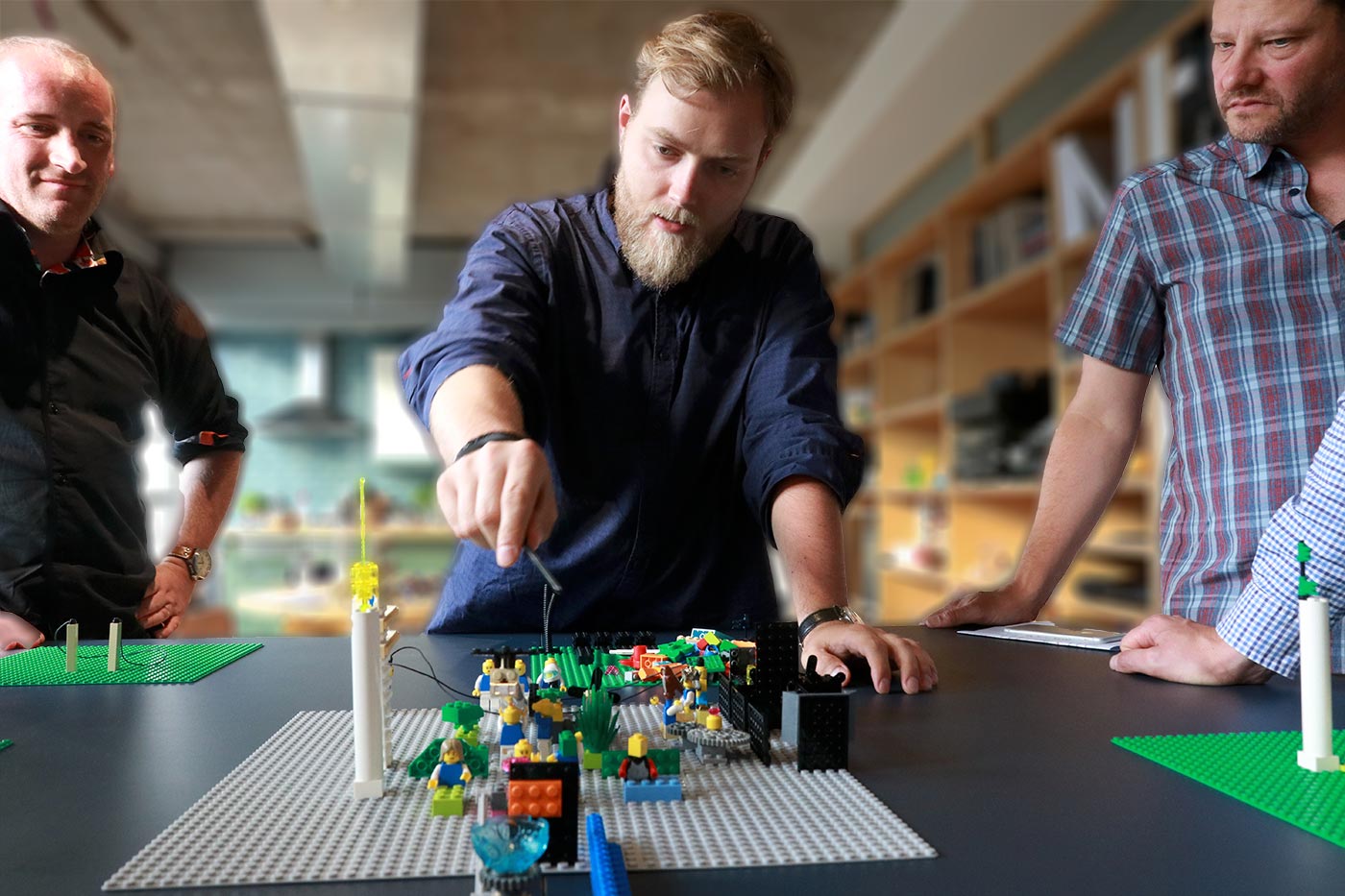



Building Belonging at School with LEGO and Purposeful Play
Belonging;
"The extent to which students feel that they are valued members of their community:
Last year I was invited to work with students, staff and parents/carers at the Bavarian International School in Munich. Over the course of two days, this whole-school community engaged in workshops focussed on an incredibly powerful - and incredibly relevant - question:
How can we be a school where EVERY student can flourish?

Why Belonging in Schools: What we can Learn from the Literature?
It is vital that students feel like they belong at school.
A perceived sense of belonging has a marked positive impact on a student’s wellbeing, levels of happiness and self esteem (Law et al., 2013). What’s more, research strongly indicates that ‘sense of belonging’ is an important variable linked to academic success (Allen, Kern, Vella-Brodick, & Waters, 2016). Not only are students who perceive themselves as valued members of their community less likely to display negative behaviours (Demanet & Van Houte, 2012), they are statistically more academically motivated and adopt a positive attitude towards learning (Roeser et al., 1996)
So - once again - it is vital that students feel like they belong at school.
The Bavarian International School acknowledged the significance of belonging for their students and took the decision to make building a culture of belonging a strategic priority. My brief was to kick start this work with the design and facilitation of a bespoke series of playful interventions to explore how they could make this culture of belonging a reality.
Our Approach: Using LEGO and Purposeful Play to Engage Students with Wellbeing
Student voice is an incredibly powerful agent for change in a school. Capturing it in a meaningful way though, can be challenging. Student surveys provide quantitative data - but often struggle to convey a rich supporting narrative. Interviews and focus groups can provide a more qualitative data set; though creating an environment where students feel comfortable enough to be completely candid can be tricky - particularly as the presence and intervention of teachers, parents or peers can unintentionally - or intentionally - distort this data (Lewis and Burman, 2008).
Play can be a fantastic mechanism for unleashing candour and gaining rich insight - even for the potentially thorniest of topics.
Working with La - the school’s Vice Principal - we designed a LEGO Serious Play workshop that challenged students to identify actions the school could take to foster this culture of belonging - starting with reflecting on the current Reality.
LEGO Serious Play: Supercharging Student Voice
Through LEGO bricks, students built models to show the school experiences that can make a student feel like they belong - or not:

This objectivity was intentional and vitally important. As we were inviting students to imagine a better future state, we needed to first provide them with the opportunity to acknowledge how things are right now - the current reality.
Having built their models - using the LEGO bricks as metaphors to communicate complex ideas - the students then shared their model-stories with their peers. It was during this story-sharing phase that we witnessed something brilliant happening…
Decoupling: The value of models in introducing Third Point Conversations

Talking about - and to - a model vs. directly to another person has a fascinating influence on the nature of a conversation. The model serves as a conduit for discussion, with comments directed at ‘it’ rather than at other people. This has two positive effects linked to potentially difficult conversation.
Firstly, the person who built the model - in telling its story - can distance themselves personally and emotionally from the ideas they are sharing. In my experience, this provides a psychologically safer space for sharing and, ultimately, increasingly unfiltered outputs.
Another positive effect is that, when a peer asks questions in response - or indeed challenges the ideas being shared - they do this via the model and in doing so, reduce the personal nature of that interaction; they are critiquing the model and the ideas that it represents, not the individual who shared them.
At the Bavarian International School, students were incredibly honest in their articulation of things that could influence a student’s sense of belonging which provided us with a rich understanding of their perceived sense of the current reality.
Shared Building: Social Learning using LEGO Serious Play
Having built and shared their individual model stories, students were then challenged in groups to combine their best ideas in the form of a shared model; one that communicated their collective response to the question: ‘what are the key factors at school that can influence a students’ sense of belonging’.
The beauty of this activity was that it challenged students to think critically about what ideas should be represented by their shared model-story. This collective response was far richer and more considered than the sum of its original parts. The use of LEGO here as a construction material was significant. It allowed for rapid iteration of ideas, with students building and rebuilding as they evolved their thinking, made new connections and organised their thinking.

Once completed, the different table groups took turns to share their models, inviting their peers to be curious and ask questions about the stories that they told.
Finally, in response to these stories, the students were invited to use this same brick-building method to generate specific ideas for how the school could foster a culture of belonging; building on the experiences that positively contribute and considering how to mitigate the negative ones.

LEGO Serious Play for Belonging: Key Learnings from this Experience
These workshops were wildly successful at engaging students with the stated objective - and they did so in a way that was full of purpose and joy! Not only did we succeed in exploring in depth the current reality, we also kick-started the process of ideating for a possible ‘ideal future state’ - all within two hours!
Here are my three key takeaways from this experience:
Want to Learn more about LEGO Serious Play in Schools?
The following resources and pathways might prove useful:
References:
Allen, K., Kern, M. L., Vella-Brodrick, D., Hattie, J., & Waters, L. (2016). What schools need to know about fostering school belonging: A meta-analysis. Educational Psychology Review, 1–34. https://doi.org/10.1007/s10648...
Demanet, Jannick, and Mieke Van Houtte. "School belonging and school misconduct: The differing role of teacher and peer attachment." Journal of youth and adolescence 41 (2012): 499-514.
Law, P. C., Cuskelly, M., & Carroll, A. (2013). Young people’s perceptions of family, peer, and school connectedness and their impact on adjustment. Australian Journal of Guidance and Counselling, 23(1), 115–140. doi:10.1017/jgc.2012.19.
Lewis, Ramon, and Eva Burman. "Providing for student voice in classroom management: Teachers’ views." International Journal of Inclusive Education 12.2 (2008): 151-167.
Roeser, Robert W., Carol Midgley, and Timothy C. Urdan. "Perceptions of the school psychological environment and early adolescents' psychological and behavioral functioning in school: The mediating role of goals and belonging." Journal of educational psychology 88.3 (1996): 408.
“People expect to be bored by eLearning - let’s show them it doesn’t have to be like that!”
- Cammy Bean
It is fair to say that LEGO Serious Play is a 'hands-on' experience. You would be forgiven for thinking that using bricks to build models and tell stories does not lend itself well to 'being online' or working remotely - particularly when working collaboratively!
Prior to the pandemic, that was the way we felt about it too... However, COVID challenged our rigid belief that a remote version of the method 'could not be done', and led us at SERIOUSWORK to adopt an increasingly disruptive mindset.
The result, Online LEGO Serious Play.
“Those who say it can't be done are usually interrupted by others doing it.”
- James Baldwin
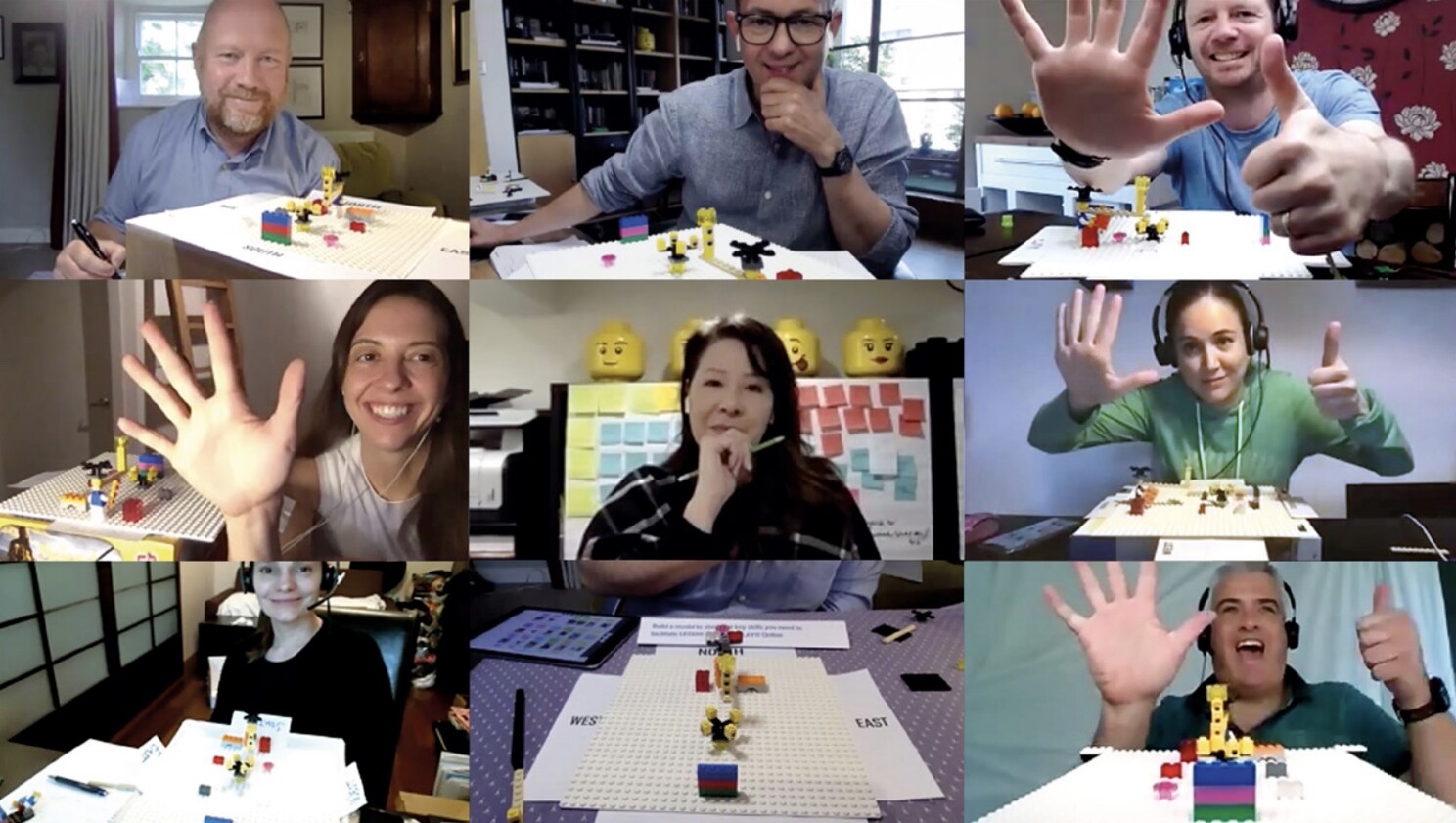
There is no doubt that COVID-19 changed the world forever - the world of work being no exception.
Today, 1 in 4 people in the UK work from home at least some of the time. Compare that with 1 in 20 in 2019 and it gives you some idea of just how much things have changed.
One thing's for sure, hybrid working habits are here to stay - and organisations must evolve to meet the shifting demands of this new paradigm.
Whilst there are obvious advantages to this brave new world , there are also unique challenges. For example, how do organisations stimulate meaningful co-creation and innovation in the online space?
Cue Online LEGO Serious Play.
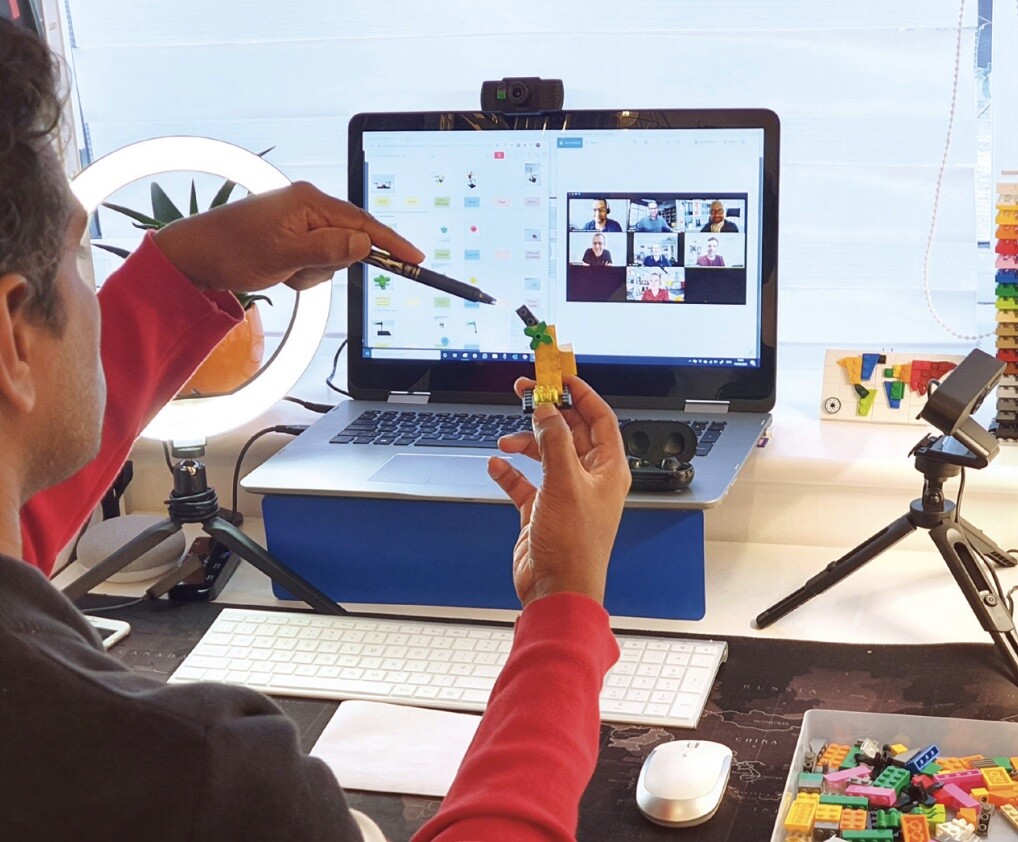
From a purely pragmatic point of view, there are some notable reasons why you might consider introducing the Online version LEGO Serious Play to your work environment:
The online version of LEGO Serious Play is similar in many ways to its better known face-to-face cousin. Participants use bricks as metaphors to build models and tell stories in response to a challenge - like a 3D printer for their thoughts. There are however some notable differences... especially when it comes to shared model building
One of the obvious challenges of Online LEGO Serious Play is that it is difficult to pick up part of a colleague's model if they are joining you on a Zoom call from the other side of the world.
This is why we at SERIOUSWORK developed the 'Magic Hands' technique. Using their 'Magic Hands', facilitators of Online LEGO Serious Play invite participants to instruct them how they would like to build - being sure to stay neutral though the use of clean questions. In this way, participants are able to construct a shared model that reflects their collective thinking and understanding.
Another unique challenge to the Online version of LEGO Serious Play, is that it is undoubtedly more difficult for participants to understand the meaning of all parts of other people's models.
Technology can play a pivotal role here in overcoming this challenge.
In our online version of the method, we use digital whiteboards to help capture the meaning of models. For shared model building, these whiteboards serve as a sort of ingredients list - with participants using them as a guide before instructing their facilitator which parts they would like to add next.
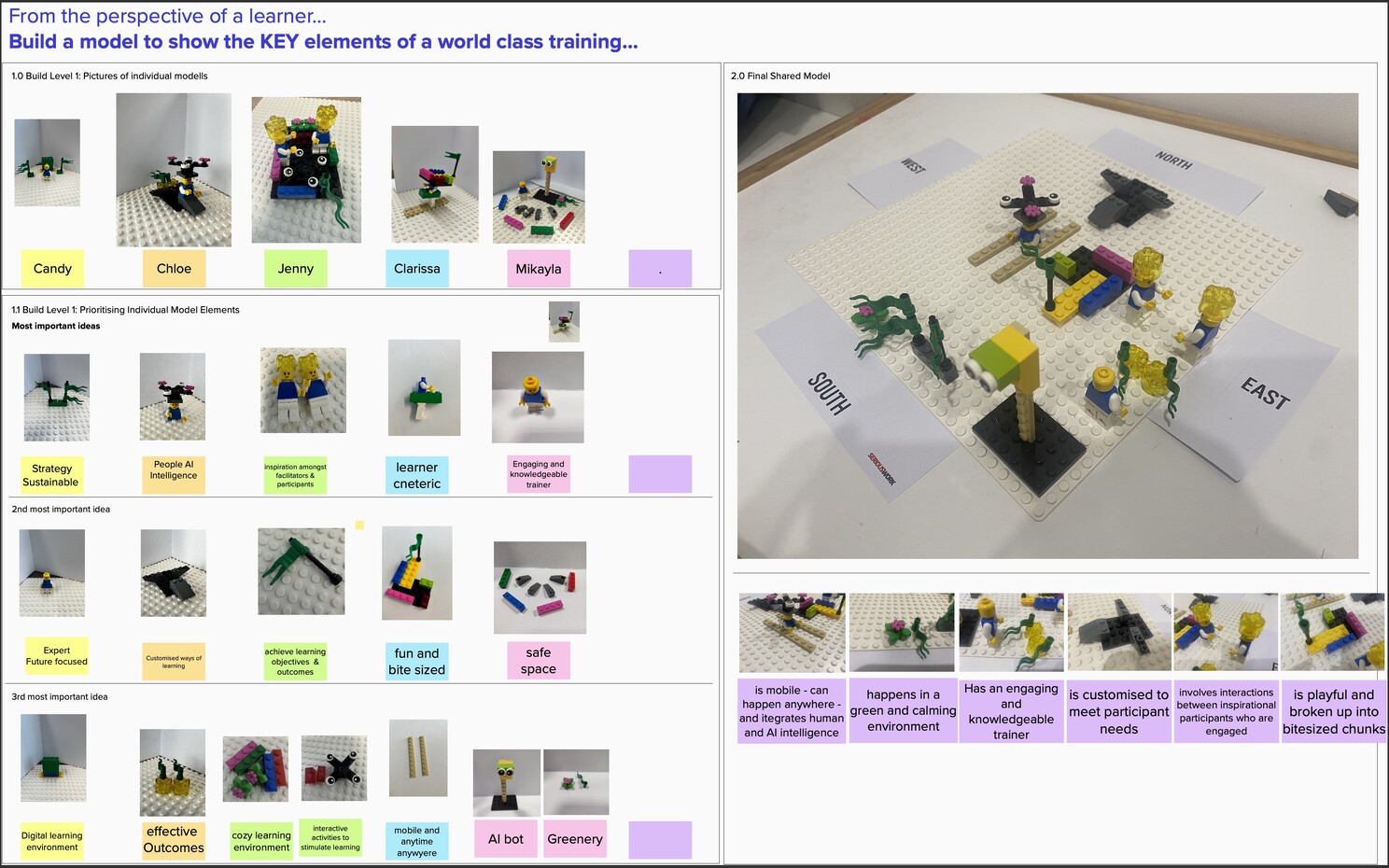
It would be easy for us to go on waxing lyrical about the value that Online LEGO Serious Play can bring to you, your clients and your teams... but instead, we thought we would share some of the feedback from people who have graduated from our Online LEGO Serious Play training:
"It opened up a new way of thinking about how learning can take place"
"It proved to be the best learning environment as I was engaged and interacting with the facilitator and participants throughout the two days online."
"I learnt how meanings and ideas can be built in constructive, innovative and playful ways.
If you are curious to learn more about how Online LEGO Serious Play could add value to you and your work, then reach out to us today.
We run public Online LEGO Serious Play trainings, but we also offer custom in-house trainings.
Here, you can make use of flexible dates and timings - spreading the training out over more than two days if necessary - and custom design; including bespoke build questions designed with your organisation's specific needs in mind.
What are you waiting for? Come Play.
The Purpose of Education
In his famous TED Talk on schools and creativity, the late-great Ken Robinson articulately shared what he saw as a significant paradigm shift in formal education’s overriding purpose; from the industrial era’s need to prepare ‘today’s youth for the factory jobs of tomorrow’, to catering for the dynamic and ever changing demands of our emergent creative economy. Given that we are not entirely sure what the jobs of tomorrow will look like, standardisation seems an increasingly shaky framework upon which to build an education system to prepare learners for future success. Personalisation of learning is one of the emergent dominant forces in education.
In this drive to ensure that all learners’ individual needs are fulfilled, modern education systems are required to focus on much more than just academic rigour and success, acknowledging the need to educate ‘the whole child’. As well as ensuring that a student’s social, spiritual and emotional needs are catered for, this holistic approach means that there is now much greater focus on developing learner’s 21st Century Skills; ‘the knowledge, life skills, career skills, habits, and traits that are critically important to student success in today's world' (Bellanca, 2010).
In the wake of COVID-19, volatile geo-political developments and the polarising influence of social media, education systems around the world increasingly find themselves with a moral obligation to make the development of these 21st century skills a strategic priority. This super power suite of traits and skills are not only in huge demand when it comes to employers’ wants and needs they are also essential if future generations are to rise to the complex systemic challenges of climate change, sustainable development and peace building.
Through my experiences, I have observed how LEGO Serious Play can play an important role in supporting this essential drive towards an increasingly holistic education system, providing learners with the opportunities and experiences needed to develop and hone their 21st century skill set.
LEGO Serious Play and 21st Century Learning
Here I explore the merits of LEGO Serious Play as a tool to develop a selection of these key 21st Century Skills - The Four C's; Creativity, Citizenship, Communication and Critical thinking.
Creativity
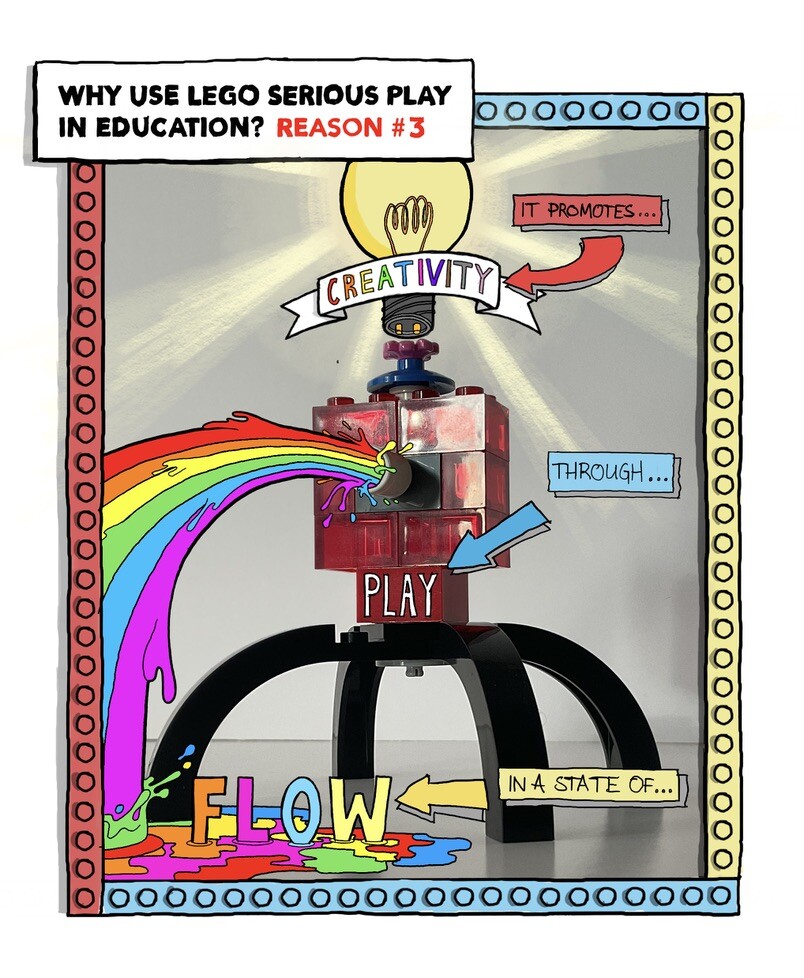
It is easy on face value to understand how LEGO Serious Play fosters creativity. Building models that use bricks as metaphors requires the learner to engage in a range of what are often considered ‘creative behaviours’; problem solving, risk taking, and lateral thinking.
I regularly observe these behaviours ‘in action’ during LEGO Serious Play workshops. Perhaps the best examples emerge from the ‘Bricks as Metaphor’ Skills Build activity; where learners use bricks as representations of ideas. It is often inspiring to witness 11 year olds articulately and ingeniously, communicating complex concepts - from the meaning of life to diversity - using just a few assembled LEGO bricks. What is arguably even more impressive is how the same learners - as they engage in future iterations of this same activity - become ever more adept at thinking laterally in this way to convey meaning; and are then able to transfer this skill to a new and novel context as they take on their individual and subsequent shared builds.
However, fully defining creativity - and therefore fostering it - can be challenging (Simonton, 2018). What constitutes ‘creative’ actions, behaviours and outcomes is often subjective, and sometimes divisive. To understand how LEGO Serious Play can fully foster learners’ creativity, it is useful to first outline what we perceive creativity to be. Jerome Bruner (1960) - a champion of Constructivist theory - believed that ‘the essence of creativity is figuring out how to use what we already know in order to go beyond what you already think’.
This notion of creativity as a skill that can be developed - rather than a series of ‘lightbulb’ moments - is echoed in the work of other prominent eductionalists; Amabile (1983) and Ken Robinson (2015) to mention just two. In recognising that creativity is not fundamentally innate, we can appreciate how, through the adoption of a growth mindset, learners can build their capacity for creative-thinking and behaviours.
LEGO Serious Play can be considered an ideal match for Bruner’s constructivist ideas on creativity - hardly surprising given its grounding in the philosophy. Through the process of building models, learners use their existing knowledge as a foundation upon which to construct new knowledge; often in response to challenging stimuli. This construction of new knowledge is what is often referred to as ‘little-c’ creativity.
'Big C' Creativity: major productions of scientific, technological, social, or artistic importance. Examples include Einstein’s Theory of Relativity; the invention of the iPhone; Da Vinci's Mona Lisa
'Little c' creativity: an individual's personal creation of new knowledge, useful ideas or solutions within their own context and zone of influence. Examples include solving a Maths problem or building a LEGO model of a sibling
In this respect, creativity - and consequently the construction of new knowledge - is at the heart of all learning. The models generated through LEGO Serious Play serve as a tangible representation of this creative process; allowing learners to see in a very accessible way how their new learning and ideas have grown from their pre-existing knowledge structures; or what they already knew.
The big question that remains is, ‘how do we know that this creative process is actually useful’? In an educational context, for learning to be useful, it should be meaningful and valued. Developmental Psychologist Howard Gardner (1988) believes that new knowledge and ideas generated through creative thinking and behaviours can be considered useful when validated by the ‘field’; the community within which they are generated. In LEGO Serious Play, these communities exist as the build groups and classes that are inherently built into the process. What’s more, the necessity to share model stories at various stages means that all learners’ ideas are regularly communicated to their immediate peers. From here, through reflection questions and subsequent shared and meta builds, ideas are challenged and validated - or not - through their inclusion in, or exemption from, subsequent group build activities.
In this way, LEGO Serious Play can serve as a powerful tool to boost creative capacity in learners and indeed, whole cohorts; providing opportunities to engage in creative behaviours, coupled with a framework that provides balances and checks that ensure creative thinking is focussed and relevant.
Citizenship
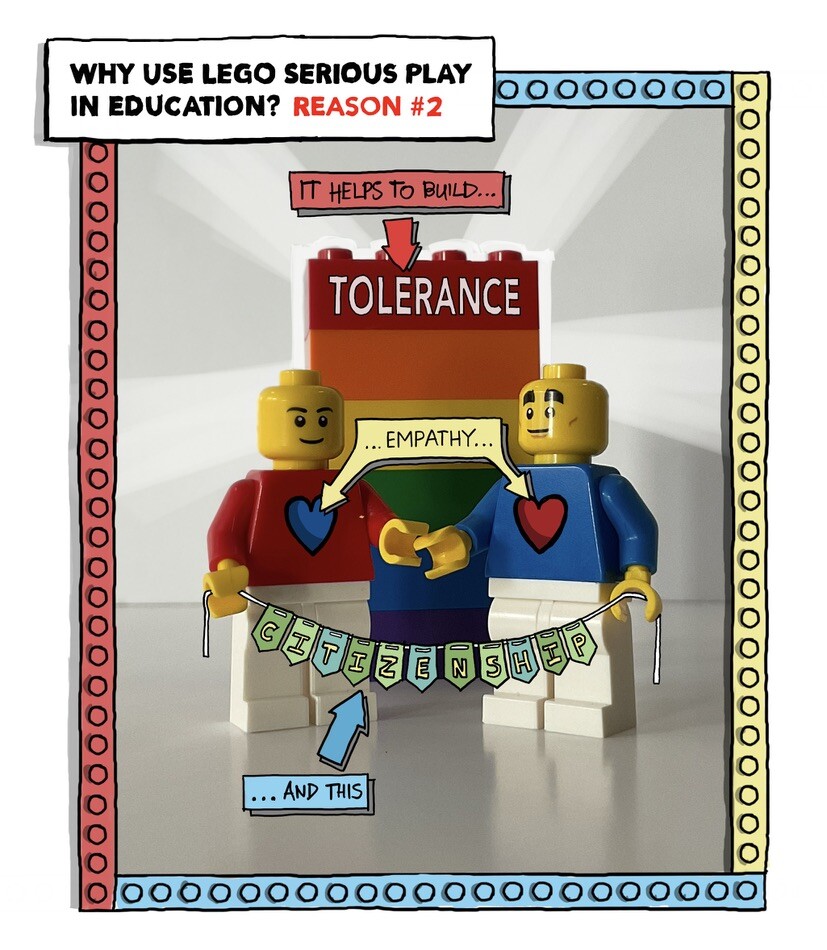
To be a good citizen is to positively contribute to society. To be educated about citizenship, learners must understand the concept of community - in both the micro and macro contexts - and recognise how their own actions and behaviours can influence their community’s dynamic.
People working together on a LEGO Serious Play Shared Build form a mini community. The process demands that each individual contribute to and interact with each other. In our experience, these community interactions - informed by LEGO Serious Play’s guiding principles - provide an outstanding opportunity for learners to develop their sense of what constitutes a good citizen.
Above all else in this regard, LEGO Serious Play promotes tolerance.
My previous school - UWCSEA - is a large international school in South East Asia; a proverbial cultural melting pot. With a diverse student, staff and community population, the school mission makes explicit its aim to ‘use education as a force to unite people, nations and cultures for peace’. A fundamental foundation for peace is tolerance for the opinions, beliefs and values of those who do not necessarily share the same opinions, beliefs and values as you.
Having observed how students and staff within our school community behaved whilst engaged in LEGO Serious Play workshops, it is easy to advocate for the extent to which tolerance is inherently built into this process.
The focus on active listening and the need to recap and summarise the ideas of others ensures that participants must truly listen, hear and understand the stories that their peers choose to share. In schools, this default to mutual respect is not always the case in all learning environments, with students often eager to share their own ideas whilst not fully appreciating those of their peers. LEGO Serious Play challenges this default to myopia. As one student put it in her workshop feedback:
“I felt that it made us listen more carefully and through paraphrasing, allowed us to understand each other's thoughts and concepts better”
In my experience, the shared model build is where the process’s capacity for fostering tolerance truly comes to the fore. In one workshop, when it came to constructing a shared response to the build question, not a single student chose one of their own ideas to contribute to the final model; instead preferring to select elements of their peers’ individual builds.
The significance of this is that our students evidenced that they not only heard and appreciated the diversity of ideas that emerged, they validated these different ideas by choosing to contribute these to the group response over their own.
This willingness to explicitly value the ideas of one’s peers over one’s own is an outstanding analogy and blueprint for tolerance and citizenship.
Communication
‘Communication is appropriately interacting with others to convey meaning and gain understanding for multiple purposes, settings, and audiences’

It is fair to say that communication is a multi faceted skill. Communicating in writing for example, is very different to communicating through the spoken word, with both possessing their pros and cons, and being variably appropriate for different situations.
One huge positive of communicating through models in LEGO Serious Play, is that it provides a buffer space between learners and the ideas they are sharing. We have observed that, by allowing the model - rather than the individual - to take centre stage in this manner, participants are less guarded about sharing their thoughts, reflections and ideas; even when these might prove controversial. This has proved particularly powerful for activities where students have been exploring socially sensitive issues; something that can be incredibly challenging for status aware youngsters to do; especially when this process is facilitated by very “uncool” authority figures such as their teachers.
For example, in a workshop where Middle School students explored their relationship with Social Media - very much a ‘powder keg’ issue - learners used their models to frame their own ideas as the views of both themselves and their peers, without worrying that their ideas would directly reflect their individual opinions. This offered the school leadership team a more authentic less filtered reflection of how our student body really felt about social media.
This ‘veil of anonymity’ that LEGO Serious Play offers participants throughout the process is a significant positive case for its’ use within schools as a tool to aid and support more effective and transparent communication.
Critical Thinking

The reflection phase of the LEGO Serious Play method is the most important; especially when analysing it through the lens of education. It affords learners the opportunity to review information, identify patterns and appreciate others’ perspectives; or, to think critically.
Critical thinking is a high order thinking skill. When thinking critically, learners make informed decisions, as opposed to rash ones (Ennis, 1991); they question what they learn, ‘thinking beyond the print’ to explore alternatives and possibilities; they connect the dots, appreciating concepts such as the transfer of knowledge and interdisciplinary learning.
This makes critical thinking an essential prerequisite for lifelong learning; equipping individuals with the necessary mindset and thinking skills to be autonomous, self directed and ultimately, to learn independently. Already identified as important within industry, these attributes are likely to be increasingly valued as individuals will be expected to pivot, retrain and relearn during what is likely to be not just one, but multiple ‘careers’ over the course of their working lives.
Even at its most base level, LEGO Serious Play supports the development of this skill simply by explicitly ring fencing time within the process for meaningful and intentional reflection. For individual builds, reflection questions provide a framework for critical thinking; encouraging participants to be objective and to look for patterns and differences within the various model stories shared. For shared builds, these questions can help learners to identify what might be missing from their collaborative efforts, or even engage in discussions about ‘to what extent’ they personally agree with their built outcomes.
In typical learning environments, in the rush to race through the content, it can often be these opportunities for meaningful reflection that are cut from an otherwise busy lesson. In LEGO Serious Play, the process simply does not work without the inclusion of such reflection steps and therefore, opportunities for learners to build their capacity to think critically always exist. As one learner put it in their post session feedback:
“The process made it really easy to visualise and think systematically about which components interconnected with one another. This helped me understand the content better.”
The reflection questions themselves - carefully crafted by the teacher-facilitator - are often tailored to their learners' needs and ability levels. Whilst they might be prescriptive for younger learners, we have enjoyed success in stripping away these frameworks for more mature learners; increasingly encouraging them to be more independently reflective.
What’s more, 'getting creative' with how to facilitate reflection can yield even more exciting results. We have explored a range of different reflection strategies - from the introduction of stimuli cards through to the incorporation of classic design thinking tools like affinity mapping. We will go on to explain how a number of these techniques have been applied to build learners' collective capacity for critical thinking later in this book.
Collaboration
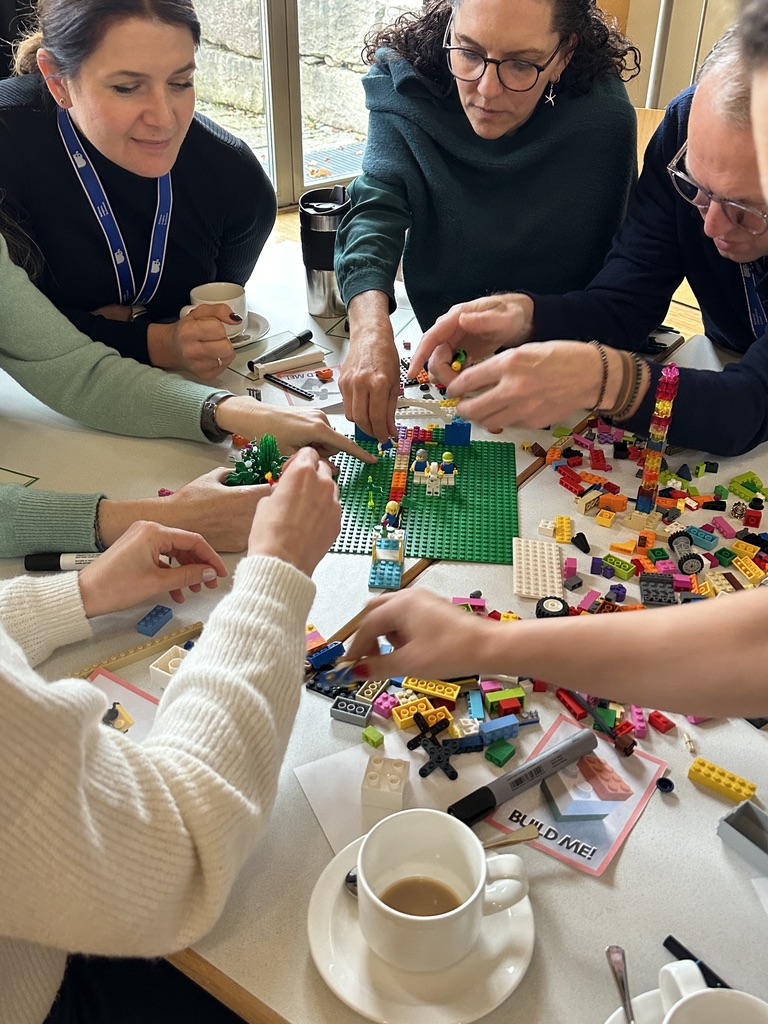
LEGO Serious Play is democratic - 'everybody builds, everybody shares’. This equitable engagement has two significant positive impacts on all learners.
Firstly, it provides every individual with an equitable platform to share their story and reflections linked to the concept being explored. For a whole host of reasons - established social hierarchies, different languages, cultural norms and learning needs, as well as the behavioural chasm between introvert and extrovert personalities to mention just a few - this equity can be very difficult to achieve in ‘typical’ learning environments. LEGO Serious Play flattens these hierarchies, making it easier for all learners to have a voice with which to socialise their thinking.
Secondly, this method means that all learners benefit from actively listening to the perspectives of their peers. Group dynamics are less of a factor in determining whose ideas are given more credibility or ‘air time’.
In socialising all learners' knowledge, the group is able to draw from the full spectrum of opinions and ideas in collaborating to develop a shared understanding.
During shared builds, participants are actively encouraged to draw from all ideas put forward, regardless of whose story they initially came from; working as a cooperative to co-create shared understandings, over which the whole group has a distributed sense of collective ownership.
What’s more, planned reflections and reviews allow the group to legitimise individual concerns throughout the process, ensuring that all learning outcomes organically adapt to at least consider a full spectrum of perspectives; affirmative and critical. This democratic approach allows for consensus to be reached by entire groups on the relevance and appropriateness of learning outcomes, even where individual learners may not completely agree with every aspect of it.
The feedback I have received from learners has always highlighted the democratic nature of this process as a significant positive. This notion is best epitomised by the post-session feedback received from one of our students, stating that "they appreciated the opportunities for all individuals to actively participate”.
Summary: LEGO Serious Play and Learning
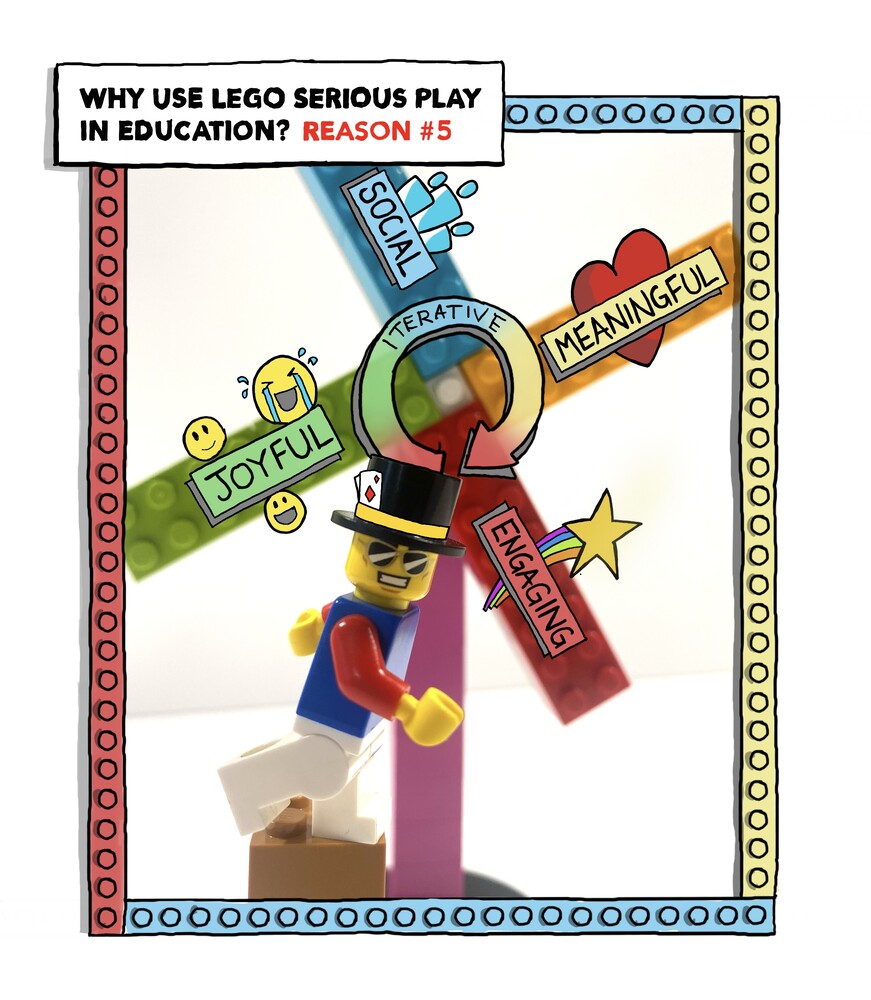
My experiences have strengthened my belief that there is definitely a place for LEGO Serious Play in education. Where used well, it has a profound and positive impact on learners of all ages, both in and outside of the classroom.
Significantly, I have been impressed with how the process supports the holistic education of the whole learner; building their capacity to be better people alongside their development of skills and conceptual understandings.
Whilst there are undoubtedly justifications for use of LEGO Serious Play beyond those outlined here, this summary captures the primary reasons why I believe it is a valid method that positively impacts learning.
Blog Post by SeriousWork Graduate and ProMet associate Vics Bradley.
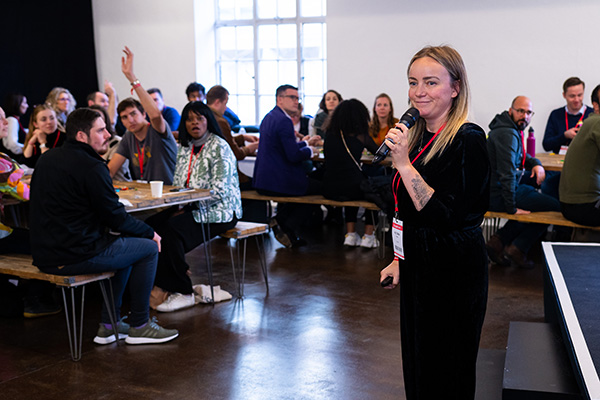
I think most facilitators, like me, feed off of the positive energy of others. That’s why I felt so grateful to be back at a buzzing conference. I was ready to be super charged like a Tesla.
Legal Geek did not disappoint. I found myself in London, surrounded by 2000 attendees from the legal sector for a very unique conference experience. Lots of talking, lots of laughing and a casual but productive buzz in the air. For those unfamiliar, Legal Geek is a tech innovation conference for the legal sector.
I was there representing the ProMeet facilitation team to deliver LEGO Serious Play workshops with a focus on sustainability in the legal sector.
These were short workshops of 45mins that really pushed participants to think and act quickly. I often think that shorter workshops are more challenging than the usual half-day of full-day we are accustomed to.
On the train down to London, I had been watching ‘Better Call Saul’ which felt like a nice coincidence. I was expecting some Howard Hamlin and Chuck McGill style characters… I was very wrong.
Around 120 attendees embarked on a 45min introduction to LEGO Serious Play and an exploration into sustainability in the legal sector. The room was packed with what turned out to be some of wildly creative minds. There was a wave of anticipation, excitement and laughter in the air.
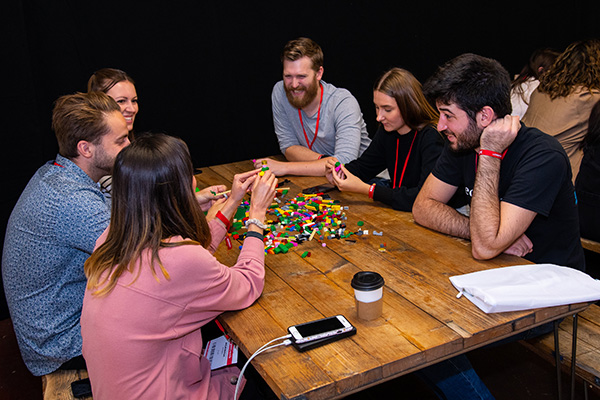
Firstly we completed some warm up builds to familiarise the room with using the bricks and to encourage attendees to embrace their curiosity. After that we were ready to jump into our builds. I asked the attendees to;
“The year is 2032 and you’ve just been crowned ‘The World’s Most Sustainable Legal Firm’. Build a shared model to showcase the ideas your firm implemented to win this title.”
This question was designed to fit one of the conference’s themes of sustainability. It encouraged attendees to consider sustainability impact, and what ideas they could implement now, that could lead to sustainable change.
The shared models were quite fascinating and definitely generated some laughs. Here is a summary of some of the stories that were shared;
Make law completely open source, build better legal transparency and dissolve the need for legal firms all together.
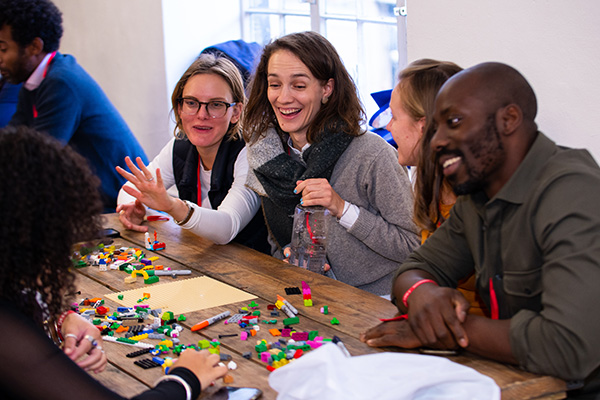
Supporting green startups pro-bono until they grow, replant trees to become carbon negative, generate our own water and electricity.
Have our client’s lead on the design of the services they need so that we support them better.
Use less paper, make lawyers self sustaining, have more women in leadership positions and implement systems for better work-life balance.
And a crowd favourite…
“Every time a lawyer recommends litigation they have to plant four trees.”
The best thing about LEGO Serious Play is the amazing array of outcomes it produces. It’s such a brilliant mix of a creativity and process. It’s a joy to facilitate this kinaesthetic learning style. I always leave with a smile, and with my batteries fully charged.
Myriam Hadnes runs the Workshops Work Podcast, and in episode 136 she interviewed SeriousWork founder Sean Blair, in her LinkedIn post Myriam said:
"Three (soon to be four) books on the subject, decades of experience facilitating workshops, and experience of training facilitators in it… Sean Blair is a #LEGO #SeriousPlay oracle! I was hoping to uncover some new insights and ideas from our conversation, but I actually found a great deal more.
Sean is such a captivating person - open and reflective - that we ended up discussing the limits of LEGO Serious Play as much as its merits.
We disagreed, we provoked, we learned. It was one of my favourite interviews to date! There’s something for everyone in this episode, so I really hope you take the time to listen. You won’t regret it"
It was great to be interviewed by Myriam, she is a gifted questioner and brilliant interviewer!
Or watch the YouTube video of both parts here.
Timecodes
01:02 When did you start calling yourself a facilitator?
02:11 How have you changed from being a “bossy” facilitator and what have you become instead?
05:05 How do you train other facilitators – especially in the art of dialling up and down their presence in the room?
09:50 What does it take to create a learning space that encourages and values mistakes?
13:54 How does speaking with your own voice play out in facilitation?
18:28 What makes a workshop fail?
20:55 How would you start a workshop for a group in which you know there is conflict and politics?
25:13 What is the power in using LEGO to help us talk about difficult topics?
28:11 Do you use ‘minifigures’ (avatars or representations of people) in your LEGO Serious Play workshops?
32:01 How do you negotiate the risks of a representation being misinterpreted between participants and creating misalignment?